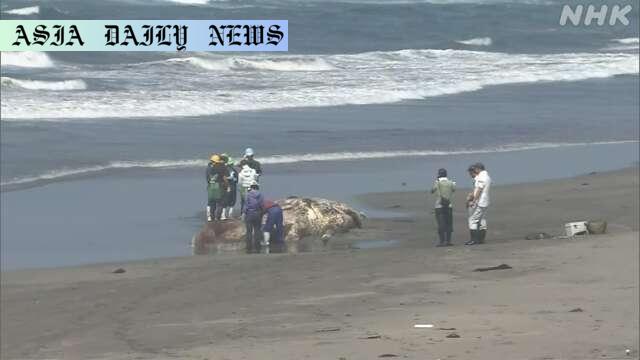Whales found stranded on Heisaura beach in Tateyama City on July 29 provide valuable scientific data for researchers.
- Researchers examined four whales washed ashore on Heisaura beach.
- Whales were measured, sampled for DNA, and studied for ecological purposes.
- It is uncommon for multiple whales to wash ashore simultaneously.
- New data is expected to aid in sustainable whale resource management.

Introduction: Unearthing Whale Mysteries
In an intriguing development, a group of scientists began an intensive study on four whales that washed ashore in Japan’s Chiba Prefecture. Found stranded on Heisaura beach in Tateyama City on July 29, these whales presented both a rare occurrence and a unique research opportunity. More than 20 experts, including scientists from the Institute of Cetacean Research, descended upon the beach to collect crucial data about the individuals and their species as a whole. The overarching goal of the investigation was to enhance understanding of whale ecology and better manage marine ecosystems.
Comprehensive Data Collection and Analysis
The research team conducted detailed analyses on-site. Samples of skin and teeth were meticulously gathered for DNA testing, while detailed measurements were taken of the bodies of the whales to determine both their sizes and their genders. Among the four, three were identified as male sperm whales with lengths ranging between 12 and 14 meters. The fourth whale, reduced to only its skeleton, still contributed important information to the study. Such data not only paints a clearer picture of the physical characteristics of stranded whales but also holds keys to understanding larger patterns governing marine life in waters near Japan.
Why Multiple Beachings Are Uncommon
One of the study’s most intriguing facets is the rarity of multiple whales washing ashore in the same area at the same time. While such phenomena are uncommon globally, researchers hypothesize that the geographic characteristics of Japan’s eastern coast may play a role. According to Tamura Tsutomu of the Institute of Cetacean Research, the contours of the shoreline might sometimes lead to an uptick in marine animal strandings. This perspective not only adds context to the scientific data but also underscores the importance of geographical considerations in wildlife conservation efforts.
The Broader Implications
The culmination of this research promises to yield insights far beyond the four individual whales. Data from this study will be integrated into broader efforts to sustainably manage whale populations and their habitats. These findings are particularly significant in the context of escalating environmental concerns and debates over the use of marine resources. Scientists and policymakers alike will benefit from the expanded knowledge base gleaned from these stranded whales, providing a solid foundation for addressing challenges within marine ecosystems.
Conclusion: A Step Toward Sustainable Marine Conservation
While the sight of four whales washed ashore is undeniably somber, it has spurred valuable scientific inquiry that holds the promise of meaningful contributions to marine conservation. By understanding both the biological and environmental factors influencing such events, researchers are not only gaining a closer look at the lives of these magnificent creatures but also paving the way toward more effective conservation strategies. As work continues, the insights derived from these studies will remain indispensable in preserving the balance of our planet’s marine ecosystems.



Commentary
A Rare Opportunity for Deep Scientific Exploration
The news of four whales washing ashore on the same beach in Japan might initially evoke sadness. Such events are a stark reminder of the delicate balance in our marine ecosystems. However, this rare occurrence offers researchers a unique opportunity to deepen their understanding of whale ecology and behaviors. For those invested in conservation science, such moments can serve as turning points where detailed data can be converted into actionable knowledge, with the aim of preserving these magnificent creatures.
The Role of Geography and Strandings in Marine Biology
As researchers pointed out, the geographical peculiarities of certain regions, such as Chiba Prefecture’s shoreline, might explain why such strandings occur. This aspect highlights the interconnectedness of species and their habitats. From ocean currents to underwater topography, understanding these factors is not only fascinating but crucial in predicting and possibly preventing future beachings. One cannot help but wonder whether advances in technology, such as AI modeling, could now be leveraged to map these high-risk zones, helping to mitigate such unfortunate events.
Looking Toward the Future: Conservation and Education
In a world grappling with environmental concerns, the studies conducted on such beached whales could become invaluable. They have the potential to inform better policies, inspire international cooperation, and spark innovative solutions for marine conservation. Moreover, increasing public awareness about these creatures and their habitats could lead to greater advocacy for their protection. By learning from the present, we better prepare for a sustainable future in which marine biodiversity thrives.
Conclusion: Stranding Events as Call to Action
While the loss of these four whales is unfortunate, it serves as a stark reminder of humanity’s responsibility toward the natural world. We must view these occurrences not merely as isolated incidents but as indicators of larger environmental phenomena. By focusing on research, education, and sustainable practices, we can ensure that these magnificent creatures are not only subjects of fascination but enduring beneficiaries of our efforts. Let this be a call to action for greater responsibility and care for marine life.